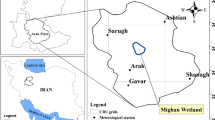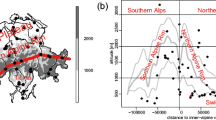Abstract
In this paper, a subsampling-based testing procedure for the comparison of the exceedance distributions of stationary time series is introduced. The proposed testing procedure has a number of advantages including the fact that the assumption of stationary can be relaxed for some specific forms of non-stationary and also that the two time series are not required to be independently-generated. For this purpose, a test based on the Kolmogorov–Smirnov and the L 1-Wasserstein distances between generalized Pareto distributions is introduced and studied in some detail. The performance of the testing procedure is illustrated through a simulation study and with an empirical application to a set of data concerning daily maximum temperature in the 17 autonomous communities of Spain for the period 1990–2004. The autonomous communities were clustered according to the similarities of the fitted generalized Pareto models and then mapped. The cluster analysis reveals a clear distinction between the four northeast communities on the shores of the Bay of Biscay (which are the regions exhibiting milder temperatures) and the remaining regions. A second cluster corresponds to the southern Mediterranean area and the central region which corresponds to the communities with highest temperatures.





Similar content being viewed by others
References
Alonso AM, Maharaj EA (2006) Comparison of time series using subsampling. Comput Stat Data Anal 50:2589–2599
Balkema A, de Haan L. (1974) Residual life time at great age. Ann Probab 2:792–804
Brunet M, Jones PD, Sigro J, Saladi O, Aguilar E, Moberg A, Della-Marta PM, Lister D, Walther A, Lopez D (2007) Temporal and spatial temperature variability and change over Spain during 1850–2005. J Geophys Res 112:D12117. doi:10.1029/2006JD008249
Cameron D, Bevin K, Tawn J (2001) Modelling extreme rainfalls using a modified pulse Bartlett–Lewis stochastic rainfall model (with uncertainty). Adv Water Resour 24:203–211
Castillo E, Hadi AS (1997) Fitting the generalized Pareto distribution to data. J Am Stat Assoc 92:1609–1620
Castillo E, Hadi AS, Balakrishnan N, Sarabia JM (2004) Extreme value and related models with applications in engineering and science. Wiley, New Jersey, p 362
Chavez-Demoulin V, Embrechts P (2004) Smooth extremal models in finance and insurance. J Risk Insur 71:183–199
Coles SG (2001) An introduction to statistical modeling of extreme values. Springer, London, p 228
Davison AC, Smith RL (1990) Models for exceedances over high thresholds. J Roy Stat Soc B 52:393–442
de Haan L, Ferreira A (2006) Extreme value theory: an introduction. Springer, New York, p 417
de Zea Bermudez P, Kotz S (2010a) Parameter estimation of the generalized Pareto distribution. Part I. J Stat Plan Inference 40:1353–1373
de Zea Bermudez P, Kotz S (2010b) Parameter estimation of the generalized Pareto distribution. Part II. J Stat Plan Inference 40:1374–1388
Draghicescu D, Ignaccolo R (2009) Modeling threshold exceedance probabilities of spatially correlated time series. Electron J Stat 3:149–164
DuMouchel WH (1983) Estimating the stable index α in order to measure tail thickness: a critique. Ann Stat 11:1019–1031
Eastoe EF, Tawn JA (2012) Modelling the distribution of the cluster maxima of exceedances of subasymptotic thresholds. Biometrika 99:43–55
Fernández-Montes S, Rodrigo FS (2012) Trends in seasonal indices of daily temperature extremes in the Iberian Peninsula, 1929–2005. Int J Climatol 32:2320–2332
Furió D, Meneu V (2011) Analysis of extreme temperatures for four sites across Peninsular Spain. Theor Appl Climatol 104:83–99
Furrer EM, Katz RW (2008) Improving the simulation of extreme precipitation events by stochastic weather generators. Water Resour Res 44, W12439. doi:10.1029/2008WR007316
García-Herrera R, Díaz J, Trigo RM, Hernández E (2005) Extreme summer temperatures in Iberia: health impacts and associated synoptic conditions. Ann Geophys 23:239–251
Gupta A, Liang B (2005) Do hedge funds have enough capital? A value at risk approach. J Financial Econ 77:219–253
Jonathan P, Ewans K (2013) Statistical modelling of extreme ocean environments for marine design: a review. Ocean Eng 62:91–109
Katz RW, Parlange MB, Naveau P (2002) Statistics of extremes in hydrology. Adv Water Resour 25:1287–1304
Kotz S, Nadarajah S (2000) Extreme value distributions: theory and applications. Imperial College Press, London, p 196
Lauridsen S (2000) Estimation of value at risk by extreme value methods. Extremes 3:107–144
Leadbetter MR, Lindgren G, Rootzén H (1983) Extremes and related properties of random sequences and processes. Springer, Berlin, p 336
Letretel C, Marcos M, Martín-Míguez B, Woppelmann G (2010) Sea level extremes in Marseille (NW Mediterranean) during 1885–2008. Cont Shelf Res 30:1267–1274
Mackay E, Challenor P, AbuBakr S (2011) A comparison of estimators for the generalised Pareto distribution. Ocean Eng 38:1338–1346
Mendes JM, de Zea Bermudez P, Pereira J, Turkman KF, Vasconcelos MJP (2009) Spatial extremes of wild fire sizes: Bayesian hierarchical models for extremes. Environ Ecol Stat 17:1–28
Méndez FJ, Menéndez M, Luceño A, Losada IJ (2007) Analyzing monthly extreme sea levels with a time-dependent GEV model. J Atmos Oceanic Technol 24:894–911
Menéndez M, Méndez FJ, Izaguirre C, Losada IJ (2009) The influence of seasonality on estimating return values of significant wave height. Coast Eng 56:211–219
Mínguez R, Tomás A, Méndez FJ, Medina R (2013) Mixed extreme wave climate model for reanalysis databases. Stoch Environ Res Risk Assess 27:757–768
Naveau P, Nogaj M, Ammann C, Yiou P, Cooley D, Jomelli V (2005) Statistical methods for the analysis of climate extremes. C R Geosci 337:1013–1022
Niu XF (1997) Extreme value for a class of non-stationary time series with applications. Ann Appl Probab 7:508–522
Nogaj M, Yiou P, Parey S, Malek F, Naveau P (2006) Amplitude and frequency of temperature extremes over the North Atlantic region. Geophys Res Lett 33:L10801. doi:10.1029/2005GL024251
Northrop PJ, Jonathan P (2011) Threshold modelling of spatially-dependent non-stationary extremes with application to hurricane- induced wave heights (with discussion). Environmetrics 22:799–809
Pickands J (1975) Statistical inference using extreme order statistics. Ann Stat 3:119–131
Politis DN, Romano JP, Wolf M (1999) Subsampling. Springer, New York, p 363
Ribatet M, Sauquet E, Grésillon J-M, Ouarda TBMJ (2007) A regional Bayesian POT model for flood frequency analysis. Stoch Environ Res Risk Assess 21:327–339
Scarrott C, MacDonald A (2012) A review of extreme value threshold estimation and uncertainty quantification. REVSTAT 10:33–60
Scotto MG, Alonso AM, Barbosa SM (2010) Clustering time series of sea levels: extreme value approach. J Waterw Port Coast Ocean Eng 136:215–225
Scotto MG, Barbosa SM, Alonso AM (2011) Extreme value and cluster analysis of European daily temperature series. J Appl Stat 38:2793–2804
Tobías A, Scotto MG (2005) Prediction of extreme ozone levels in Barcelona, Spain. Environ Monit Assess 100(1–3):23–32
Vanem E (2011) Long-term time-dependent stochastic modelling of extreme waves. Stoch Environ Res Risk Assess 25:185–209
Acknowledgments
The authors would like to express their gratitude to the editor and the two referees. They offered extremely valuable perspectives on our work and effective suggestions for improvements. The second author would like to thank the support of the Department of Statistics of the University Carlos III, Madrid (Spain), where she stayed during her last 4 months of Sabbatical Leave. This stay was financially supported by the grant SFRH/BSAB/ 1138/2011, from Fundação para a Ciência e Tecnologia-FCT, Portugal. The research was also funded by FCT projects PEst-OE/MAT/UI0006/2011 and PTDC/MAT/118335/2010. The first author also acknowledges the support of CICYT (Spain) Grants SEJ2007-64500, ECO2011-25706 and ECO2012-38442. The third author was supported by FEDER funds through COMPETE–Operational Programme Factors of Competitiveness (“Programa Operacional Factores de Competitividade”) and by Portuguese funds through the Center for Research and Development in Mathematics and Applications (University of Aveiro) and the Portuguese Foundation for Science and Technology (“FCT–Fundação para a Ciência e a Tecnologia”), within project PEst-C/MAT/UI4106/2011 with COMPETE number FCOMP-01-0124-FEDER-022690.
Author information
Authors and Affiliations
Corresponding author
Rights and permissions
About this article
Cite this article
Alonso, A.M., de Zea Bermudez, P. & Scotto, M.G. Comparing generalized Pareto models fitted to extreme observations: an application to the largest temperatures in Spain. Stoch Environ Res Risk Assess 28, 1221–1233 (2014). https://doi.org/10.1007/s00477-013-0809-8
Published:
Issue Date:
DOI: https://doi.org/10.1007/s00477-013-0809-8




